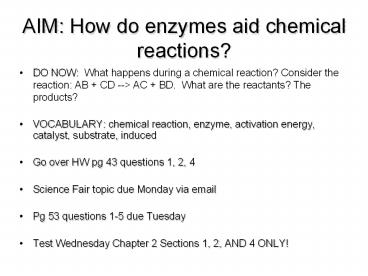AIM: How do enzymes aid chemical reactions? - PowerPoint PPT Presentation
1 / 18
Title:
AIM: How do enzymes aid chemical reactions?
Description:
AIM: How do enzymes aid chemical reactions? DO NOW: What happens during a chemical reaction? Consider the reaction: AB + CD -- AC + BD. What are the reactants? – PowerPoint PPT presentation
Number of Views:177
Avg rating:3.0/5.0
Title: AIM: How do enzymes aid chemical reactions?
1
AIM How do enzymes aid chemical reactions?
- DO NOW What happens during a chemical reaction?
Consider the reaction AB CD --gt AC BD. What
are the reactants? The products? - VOCABULARY chemical reaction, enzyme, activation
energy, catalyst, substrate, induced - Go over HW pg 43 questions 1, 2, 4
- Science Fair topic due Monday via email
- Pg 53 questions 1-5 due Tuesday
- Test Wednesday Chapter 2 Sections 1, 2, AND 4
ONLY!
2
Homework Review
- Use the structure of a water molecule to explain
why it is polar. - The oxygen molecule has a greater attraction for
the electrons. Therefore, the oxygen end of the
molecule is slightly negative, while the hydrogen
ends are slightly positive. - Compare acidic and basic solutions.
- Acidic solutions contain more H ions than OH-
ions. Basic solutions contain more OH- than H.
Acids taste sour, while bases taste bitter. - What does pH measure?
- pH measures the concentration of H in a
solution.
3
Review of Do Now
- What happens during a chemical reaction?
- Bonds are broken and re-formed.
- Consider the reaction AB CD --gt AC BD
- What are the reactants? The products?
- Reactants AB, CD
- Products AC, BD
4
Collision Theory Mrs. DAnna vs. Mike Tyson for
the (sort of) heavyweight championship of the
world!
- In order for a chemical reaction to take place,
the reactants must collide with sufficient energy
and in the proper orientation. - The initial energy required to get a chemical
reaction started is called the activation energy.
5
What energy changes take place during a chemical
reaction?
What do you think is represented by the following
labeled parts of the graph Reactants Products EA
delta G
Is this reaction endothermic or
exothermic? Explain.
6
Closing QuestionSketch an energy diagram for
the reverse chemical reaction.Should this
reaction be exothermic or endothermic?
7
Is this reaction endothermic or exothermic? How
do you know?
8
Summary
- Chemical reactions occur when bonds between
molecules are broken and reformed. - An exothermic reaction releases energy (heat)
- An endothermic reaction absorbs energy (heat)
9
What are some factors that effect enzyme
activity?
- Do Now What takes place in a chemical reaction?
What is the difference between exothermic and
endothermic? - VOCABULARY chemical reaction, enzyme, activation
energy, catalyst, substrate, induced - Science Fair topic due Monday via email
- Pg 53 questions 1-5 due Tuesday
- Test Wednesday Chapter 2 sections 1, 2, 4 ONLY!
10
What do you already know about enzymes? (2 min)
- What type of molecule is an enzyme?
- What do enzymes do?
- How do they work?
11
Characteristics of Enzymes
- Proteins
- Substrate
- Specific (lock and key)
- Induced fit (handshake)
- Biological catalysts
- Not consumed by a reaction
12
Induced Fit with Substrate
13
An Induced Fit
A
B
14
How do enzymes act as biological catalysts?
How is the red curve (enzyme added) different
from the black curve (no enzyme added)?
15
Activity
- Page 51
- Analyzing Data
- Read the passage and study the graph.
- Answer questions 1-6 in groups.
16
(No Transcript)
17
Closing Thought
- What is the effect of pH on enzyme activity?
- Why do you think this occurs?
18
Effect of Temperature and pH on Enzyme Activity































